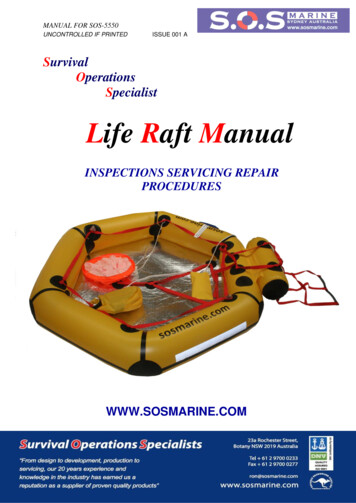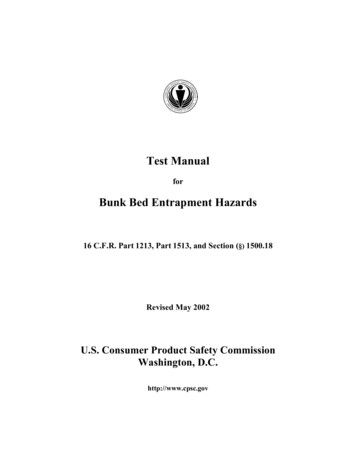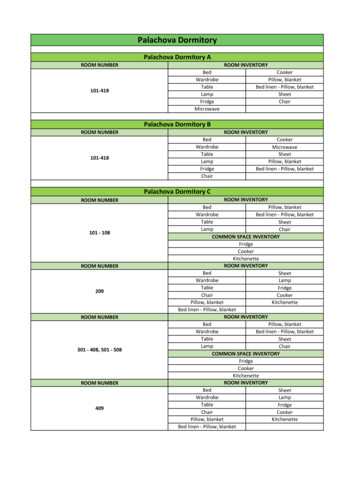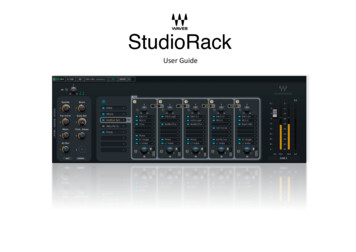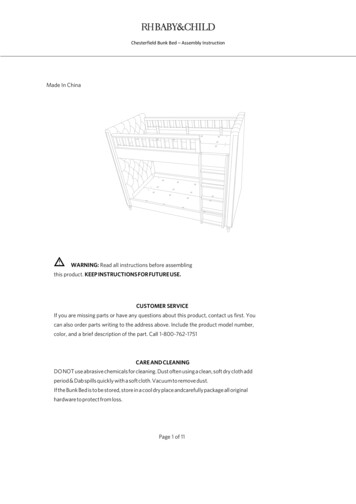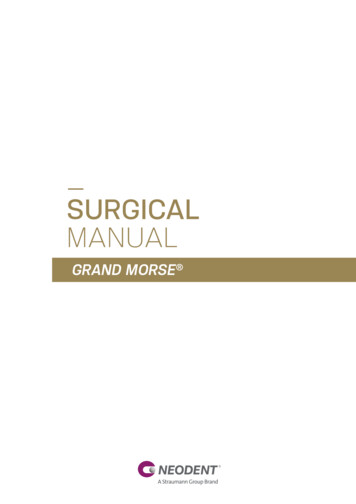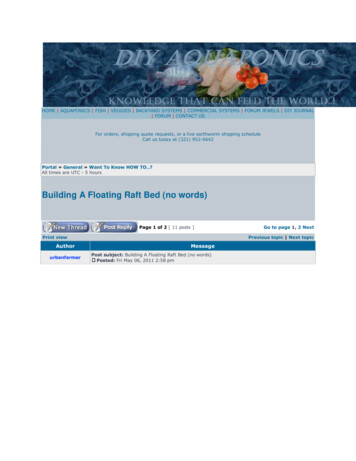
Transcription
HOME AQUAPONICS FISH VEGGIES BACKYARD SYSTEMS COMMERCIAL SYSTEMS FORUM JEWELS DIY JOURNAL FORUM CONTACT USFor orders, shipping quote requests, or a live earthworm shipping scheduleCall us today at (321) 952-6642Portal » General » Want To Know HOW TO.?All times are UTC - 5 hoursBuilding A Floating Raft Bed (no words)Page 1 of 2 [ 11 posts ]Print viewAuthorurbanfarmerGo to page 1, 2 NextPrevious topic Next topicMessagePost subject: Building A Floating Raft Bed (no words)Posted: Fri May 06, 2011 2:58 pm
Joined: Wed Sep01, 2010 9:13 amPosts: 1843Location: Zone 9b
The raft bed ended up being 16 feet x 4 feet x 15 inches height and weighedaround 6,000 pounds when full.The inside was then lined with 6 mil black polyethylene and filled with water. Ihave no pictures of the styrofoam rafts, but I drilled holes and placed seedlings inthere.A storm subsequently destroyed the raft bed (actually someone moved a brickafter the storm moved the foundation some, but it was still standing until the brickwas moved, F#@%). I dream of rebuilding it one day if time and budget allow meto.
It held 224 plants, producing 56 heads of lettuce a month.Material cost was 150 - 200 (closer to 150).Next time I would put it closer to the ground. It was a bit high up, but stillcomfortable for my height.
The raft bed ended up being 16 feet x 4 feet x 15 inches height and weighed around 6,000 pounds whenfull.The inside was then lined with 6 mil black polyethylene and filled with water. I have no pictures of thestyrofoam rafts, but I drilled holes and placed seedlings in there.
A storm subsequently destroyed the raft bed (actually someone moved a brick after the storm movedthe foundation some, but it was still standing until the brick was moved, F#@%). I dream of rebuildingit one day if time and budget allow me to.It held 224 plants, producing 56 heads of lettuce a month.Material cost was 150 - 200 (closer to 150).Next time I would put it closer to the ground. It was a bit high up, but still comfortable for my height.Material cost, 1.97 per 2x4x8 treated lumber whereas anything larger went up drastically. BUT,where would using thicker would come in handy? I felt the 2x4's on the top were MORE than strongenough to hold the water. The 4x8 sheet I have is 7/16 OSB Exposure 1; so, I painted it with selfpriming outdoor acrylic paint. I painted the edges several times and the rest of it twice to make sure itwas sealed. Those pieces are still outside looking good, LOL!What joints do I stagger? Please tell me how to build it better because I have to rebuild it anyway!!!I'm not a construction person. This was actually my first time using a power saw, nail gun, levelingground, etc.I suck at this stuff, but I'm willing to do and learn!I honestly think my material cost was around 115, but I threw in a few more bucks to round it off incase I forgot something, but I don't think I did. I'm putting away money to give it another try. It's hardsince I'm a student and gas, food, and books are my primary expenses.OH, I did use 16 gauge finishing nails as framing nails. I know this was probably a terrible idea, but Ijumped on it and kicked stuff, and it didn't budge. I may do this again because I can't afford a framingnailer and regular nails tend to split the wood.Utah Aquaponics System Construction and EarlyStartupAttached are a few photos of our Utah Aquaponic System in construction and in earlyproduction. Detailed aquaponic system design information and plant and fish selection decisionscan be found in our thread at AquaponicsHQ .php/831-Utah-System-Part-1-BeginningsAquaponic system under construction: (In mid-February 2009):
18' x 32' double poly greenhouse - - - - - - - - - - - - - Grow Bed Tank on supports
275 Gallon IBC Tote, top cut off for the fish tank - - - Propane Water Heater to heatwater
Utelite Expanded Shale for the Gravel - - - - - - - - - - Bell Siphon installed
Beds filled (leveled first) - - - - - - - - - - - - - - - - - Base for Floating Raft System- dumptank below
Fish Tank - New and Full of Water - - - - - - - - - - Gravel grow beds, water flowing in
Bell Siphon drain tube - - which flows down and - - empties into the sump tank
Floating Raft Construction Detail - covered with used vinyl sign material (hmmm, Iwonder where that came from!).
March 14 - Just 2 Weeks after planting seeds - - - May 1st 8 Weeks after planting
Lettuce 4 weeks old from seed (except large plants) - Lettuce 8 weeks old - salad time!
May 19 - 10 weeks after planting - - - - - - - - - - - - - - Betterboy Tomato - 10 weeks
Cherry Tomato's - more tomatoes than leaves - - - Greenhouse Cucumbers, ready toharvest
Water heater details, click on picture for large view. Details on the components are inthe aquaponicshq forum linked below.Got a phone call the other day and picked up a third tank for free!Aquaponics Floating Raft Upgrade
After seeing the system at Nelson and Pade in Wisconsin, I resolved to upgrade mysystem. I found these 2 x 8 feet x 1" building foam on sale and picked up a couple oflengths. Any type will do, pink or blue 4 x 8 or smaller. This was what was on sale.They use a tapered bit to drill the hole. This bit is a 1 1/8" and it makes a nice largeopening at the top for the plant, but narrow at the bottom for the roots. Best of all, I don'thave to shim the plant cubes to get them to stay in the hole. Previously I used 2" foamand cut square holes with a knife. The holes are uneven sizes, sometimes the cubes fallthrough. Using the tapered bit is nice and simple.First I cut the sheet to fit tightly into the raft tank. Any gap around the edges and thelight gets in and promotes algae and moss growth. Then I marked out the hole spacing.8" on center. My old system was 6" on center and it was to close. Eight inch spacing is
what was recommended at the seminar. Then I rough drilled the holes to about 3/4depth. The I finish drilled more carefully, running the drill on it's highest speed, allowingit to "polish" or slightly "melt" the edges to give the smooth finish you saw in theprevious pictures.I'm also switching to these rock wool cubes, rather than the horticubes. Notice howthese taper to a point. The horticubes are the opposite, with big bases and narrow tops,making them difficult to keep in the holes. These cubes are tapered to fit in the taperedholes, as can be seen by the two I have inserted. Then finally, 2 new sheets installed inthe raft system, along side an old sheet. I'll replace the old sheet as soon as the plantson it mature.1.Utah System Part 1 - BeginningsFor 10 years I have had an 18 x 32' foot (5.5 x 9.75 meters) greenhouse that wasmoved from our last house, It was never fully setup till this summer, when the plasticfinally gave out (10 years was pretty good). So I added new poly, then when my GiantPumpkins contracted Fuserium Oxysporum and died (I had 200lb (90kgs) babypumpkins by then, my personal best is 580lbs(265kgs)). I was in a sorry state.With lots of extra time on my hands, I finally repaired the greenhouse controller, PutPolycarbonate on the end wall, added power vents and thrip screen, leveled the floor,sunk the 50 gallon pond, leveled the floor by adding 2" of sand, and covered it withheavy duty black weed guard. Then filled it up with tropical fruit trees.Summer and Fall went by with good success, Lemons, Figs, Pineapples, Birds ofParadise and more. Bugs were low, a few fungus gnats, easy to control. Winter came, Ifilled the propane tank and wired up the propane space heater, keeping the tempsabove 50F degrees (10C). As our winters get cold and we had a meter of snow piledup, it cost 200 a month during the coldest season to keep the greenhouse going!That's very expensive lemons.
In December, my 10 year old son announced that he needed a science project forschool. Having looked at Hydroponics, Aeroponics, Aquaponics, Aquaculture for years,We decide to hook up a floating raft system to the small pond with its 10 Koi andGoldfish. We bought a plastic tote, rerouted the pump line, added an overflow, cutsome foam and started some lettuce.The lettuce is still growing very very slow (the water averages 45-50F degrees (8-10C)the daylight is to short. But it continues to grow. In the meantime, Dad (me) decides itstime to join the big time. So the search began for tanks, pumps, fish and information.My system is still not complete, but I thought I would document my searching’s forothers to learn from, and for others to comment on. I'll add more posts with myprogression.First item, when growing lettuce in raft, don't fill the net pots with miracle grow. Theday we moved them from the nursery to the floating raft, the air bubbles from theairstones, eroded away the media in 1/2 the pots. Now I have 1" by 1" Horticubes, andwill just forget the net pots, starting the plants in these, then putting the horticubesdirectly into the foam board in the floating raft.New Domestic System Design ToolAt Aquaponic Solutions we have developed a new domestic aquaponic system design modelfor all those people who wish to design and build their own backyard/hobby/domestic mediabed aquaponic systems. This model allows you to size the media bed (gravel bed) of yoursystem based on three important requirements: the fishfeed to plant use ratio requirment(we use the UVI ratio model for this), the biofiltration requirment (this is for people whowish to use a gravel bed as a filter and want a majority system using another hydroponicapproach, like deep flow or NFT) and the solids mineralisation requirment (to make surethat solids that enter the gravel bed are broken down and mineralised).There are many different sizing approaches for media bed aquaponic systems, but none ofthem are actually based on the use of sound or established scientific or technical principles.Our new sizing model uses established and well known associations for gravel bed biofiltersizing, fish feed input to plant use ratios and gravel bed solids mineralisation ratios.The model is provided as an excel spreadhseet for ease of use and we also provide adocument that explains the model and explains how to use the model. We hope this assistsyou with designing your backyard or hobby scale aquaponic systems. Happy aquaponicing!Aquaponics Nugget #18:Types of Aquaponics Systems (Part 2 )Today we'll cover several types of aquaponics systems, hopefully explaining their differences well enough
so you can understand and make an intelligent choice for your own system.Deep-Water Culture (often also called Raft Aquaponics). DWC in its simplest form is a fish tank and ahydroponics trough or water container of some sort. There's a pump that circulates water through thesystem, and usually an air pump or blower that supplies aeration to the fish and plants in the system. Thisis the kind of aquaponic systems we use on our farm, because they are the least expensive to build andoperate, and the most productive for the least labor. They are also currently the ONLY systems that arecertified organic.Gravel-Bed Aquaponics: These systems grow vegetables by running the system water through beds ortanks filled with different sizes and types of gravel, with the plants planted directly into the gravel. Thesesystems also have a pump, but have differing methods of aerating and circulating the water; some havewhat are called autosiphons, and are set up to operate in flood-and-drain mode where at times the graveldries out and at times is flooded; other systems simply flow the water through the gravel, just below thesurface of the gravel.We have reports of gravel bed hydroponics working for a few months in the tropics, then the bacteriaassociated with aquaponics clogging the interstitial spaces between the gravel bits, not only gluing themtogether, but also creating anaerobic decomposition zones that generate all kinds of nasty stuff that getsback into the system and uses up all the oxygen. As the system clogs it gets less efficient at growingplants and keeping fish alive, and the gravel eventually has to be removed and washed or replaced.Gravel beds seem to work much better in temperate climates, i.e. Australia, but they may still have thefollowing drawbacks:Planting into and harvesting out of gravel beds is a LOT more work than working with deep-bed rafthydroponics, where you can pick up a lightweight raft and move it to a couple of sawhorses at waist levelto do your harvesting and replanting. Gravel beds are heavy, and are either on the ground (making yourwork harder because you need to bend over for planting and harvesting), or are up at waist level on areally strong frame that costs a lot of money and labor to build. It takes work to pull a plant's roots out ofthe gravel, and work to dig a seedling cube or a 2" net pot with a seedling in it into the gravel. In somesystems there are issues with algae growing at the surface of the gravel. Some people solve these withebb-and-flow systems, which we think are a recipe for a disaster (see Ebb-And-Flow in this section).To be fair here, we also have a report from a guy who designed a gravel bed system that has gooddrainage and aeration that seems to work just fine, in Texas in a climate similar to ours in Hawaii. To beeven more fair, we have another report from someone who put in a good-sized commercial gravel bedsystem who has now removed the gravel and is using rafts in the system. We feel the labor involvedmakes these systems inapplicable to a commercial situation, and they may be more work for thebackyard aquaponic gardener.Nutrient-Film Technology (NFT) systems usually have narrow plastic troughs or pipes with a veryshallow film of water flowing along the bottom of the trough/pipe (hence the name). Although a standardin the hydroponics industry, and well-suited for a bacteria-free chemical hydroponic environment, theycan have a few problem areas:The small-size water delivery lines that deliver water to the hydroponic channels tend to clog badly withthe bacteria and crud that thrives in an aquaponics system. If the water supply is interrupted by a pumpfailure or a clog that is not caught right away, the system can lose its plants very quickly as they dry outrapidly with no water reservoir below to draw on. This is prevented in a raft system which always has
deep water below the plants. Also, NFT systems usually involve more than one pump which creates morepotential failure points than a one-pump system.The infrastructure for NFT, with all the racks, movable troughs, and greenhouses (which are required sothis stuff doesn't blow away in a big wind) is expensive, much more expensive by our estimates than theaquaponics systems we use. We are thinking of trying a modified test NFT system that we call a "thick"NFT system, with 2" of water in the troughs, and a vertical rack system. We should have this informationavailable to put in our course manuals within six months or so."System Kits", and "Complete Systems": We can't use trade names or refer to specific companiesdoing aquaponics business. However, there's a bewildering variety of systems out there that are built withold used plastic barrels (or even more expensive brand-new ones), fiberglass planting trays, plastic andfiberglass fish tanks, tank stands, custom greenhouses, special biofilters, “trademarked” this and that; itgoes on and on.We’re sure the people selling these systems are good people. But we've seen websites offeringaquaponics systems for sale that cost three to ten times as much as if you just bought the parts yourselffrom the same places they buy them. These inflated prices often do not include all the materialsnecessary to build the system, nor shipping, nor construction and assembly.There's nothing magical about the equipment these people sell. If you have someone to show you theway, you can build and operate the most economical, productive, efficient, and durable aquaponicssystems yourself, from parts and materials you buy locally. If you take the time to acquire the knowledge,you will save a ton of money, have more fun, and you will have the understanding to be able to solveproblems yourself instead of having to call on the "experts" and pay them more money.Most important, anyonecan build an aquaponics system, but operating one without goodand easily-understood information can be frustrating. Part of the information in ourmanuals is given in the form of a "Daily Operations Manual" where you simply use thechecklist and follow the step-by-step instructions on your way to success withaquaponics.(We realized that we needed a "Part 2" of "Types of Aquaponics Systems", and promise that we will putthe twice-delayed "Water Quality" Nugget in this newsletter next week).
Floating RaftsView the slideshow to see the evolution of the construction of my system.Floating rafts or Deep Water Culture (DWC) is another AquaPonics technique,developed and promoted by the University of the Virgin Islands (UVI).UVI is one of the pioneers of AquaPonics.see the links page for more info on UVI.DWC uses tanks or ponds to grow plants in on floating rafts.Plants are grown in small pots filled with media that are inserted in holes inthe rafts that keep them floatin on the water surface.The main advantage of this system is the ease of planning, sowing andharvesting of one particular fast growing crop, i.e. lettuce and herbs: verylong "raceway" ponds are calculated so that the harvesting of one or morerafts coincides with the sowing of new ones.These raceways can be as long as 100 and 200 m.The main drawback of this system is the difficulty of bringing enough oxygento the plant's roots.It is doubtful if this can be reached by passive aeration if the whole watersurface is covered with rafts.
This calls for extra investment in aeration, both in hardware (air pump,tubing and diffusers) and in energy consumption.Another problem with DWC is plant support: the small pots do not give muchstability. This is no problem for low plants like lettuce and herbs.Higher growing plants need a support to grow against, especially if outside agreenhouse and exposed to wind.A challenge to meet.I have built a small pilot DWC system in my greenhouse to study andcompare the advantages of this system to NFT and growbeds.I intend to build longer raceways outside.The bottom and sides of the tank are constructed out of a 5 mm multiplexboard stapled to a frame made of 45 x 20 mm ribs.The bottom of my DWC tank is made of two panels measuring 3 m x 1 m , thesides are 30 mm high.On the inside, 90 bookshelf supports are screwed to both bottom and sidesfor strengthening.A thick polyethylene foil (leftover from my greenhouse covering) is thenspread over the tank and carefully folded into the corners.Takes a bit of adjustment and patience, but the rectangular form of the tankis a big help.Kind of wrapping a birthday present inside out. Not really difficult, just makesure the folds in the corners always take the foil up to the rim of the tank,else it will be leaking.The rims of the foil are folded over the sides and stapled to the frame.A 50 mm tank drain fitting is installed in each growbed.For that I use a guide made of a 20 mm piece of board with a hole drilled in itwith the corresponding hole saw. I weigh that down to hold it in place.With an exacto knife I then first cut the corresponding hole out of the foil,
helped by the guide. This is important, lest the teeth of your hole saw wrapup the foil while drilling (been there, done that).After that, cutting the hole through the bottom with the hole saw is childsplay.The drain fitting is connected to the fish tank solids lifting overflow drain, sothe DWC side is not really a drain but a fill.The pump is located in the DWC tank and pumps the water back to the fishtank.The fish tank (CHIFT -see the "definitions and acronyms" page) overflowsinto a pond type filter which then overflows into the DWC tank, from which itis pumped back to the fish tank, which then overflows . etc .etc .Insulation.I have the intention of filling the gaps between the frame ribs with insulationand staple a second 5 mm board against them to close up, then screw aplastic or aluminum L-profile all around the rim and on the corners forfinishing touch.see more pictures of the construction principle on the "rectangulargrowbeds" page.I have built my own 16 x 7 m greenhouse.
View the slideshow to see the evolution of the construction.First I had the terrain leveled.The central gangway is built out of custom made aluminium ladders.Then I made the rafters which lean against this central gangway and arefastened to it.Each rafter is also anchored to the ground.Being particularily charmed by foam as insulation technique, like presentedin the the Solaroof concept (a double sided foil in which foam is injected bothfor heat and cold insulation - see the Solaroof Wiki and forum), I decided touse square PVC drain pipes 100 x 100 mm, standard length 4 m for therafters.This will allow me to have a double sided greenhouse.One word of warning: beware of the price information on both the Solaroofforum and Wiki.I participated in some discussions there.I have 25 years of experience with foaming applications for cleaning in thefood industry.When I posted some prices on what an industrial foaming product mightactually cost, I was inadvertently and without warning banned from theforum.The people who run the forum are obviously protecting their commercialinterests (which is fine with me, I am not against honest commerce, but I dooppose against hypocrisy as these people pretend to be open while they arenot. Very little useful information is given on either site, but the contributorsideas are no doubt milked out).back to my greenhouse (excuse the rant):The bottom part of the vertical side walls is made of 1 m high panels of 5 mmmultiplex stapled to a wooden frame of 45 x 20 mm planks.To isolate the panels from the humid soil, they stand on strips of 50 x 100mm Floormate insulation.I cut a 100 x 100 mm x 4 m PVC drain pipe lengthwise, which left me withtwo 100 x 50 mm x 4 m gutters which I screwed to the top of the panels forrain collection.
North, east and west sides, the hollow part of the panels is facing inwards forinsulating later on, south (sunny) side the hollow part is facing outwards forincorporating thermal solar collectors.The panels need painting as soon as the weather permits.At this moment only the outer foil is installed as I wanted to first test a newmethod for fixing the foil to the frame.For that I used 3M VHD (4952) acryl double sided sticking tape, as standardavailable in 12 and 19 mm width.This seems to be a wonderful solution: where applied under the rightcircumstances and preparation, the foil sticks very well to both PVC andaluminum profiles.Right circumstances are low humidity and temperatures above 15 C, andthorough degreasing of both supports and foil.I was late in the season, so the circumstances of humidity and temperaturewere far from ideal ( 10 C and humid).Still most parts stick extremely well (they resisted an autumn storm), and Iam convinced of the method.The foil was 8 m wide, so the covering was done in two phases.The 100 x 100 mm square drains also allow for the incorporation of electriccables and fixtures.What would I change?-Next time I will use 19 mm tape. Unfortunately at the time only the 12 mmwidth was in stock.-I will choose a dry warm windless day.-Distance between rafters is now 4 m. Next build will be maximum 3,preferably 2.5 or 2 m, certainly for a higher greenhouse (height is nowlimited to 2.5 m for building permit reasons).-And, most of all, I will ask for some help. Alone is but alone. One does a lotof walking from one side to another.Vanity, O Vanity.(Still I am quite proud of myself ;-) ).
BiofiltrationFood for the fish is the only external input to an AquaPonics system.Fish transform most of this food into muscle tissue.But like all animals, fish also produce waste.Just like in a Recirculated Aquaculture System (RAS), in AquaPonics thewaste produced by the fish consisting of settled and dissolved solids ispumped to a bio-filter system.In this bio-filter, high surface, often porous media through which the wateris pumped are colonised by beneficial bacteria.These natural bacteria convert the waste from the fish tanks, largelyammonia (toxic to fish), first to nitrite (higly toxic to fish) and then to nitrate(not toxic to fish) with the help of oxygen.It is essential to evacuate these solids from the fish tank as fast as possibleto remove ammonia and nitrite (toxic to fish).If not, they will be colonised by these bacteria, who will also compete withthe fish for the oxygen.Once the full biofiltring cycle is finished, toxicity is reduced to acceptablequantities for the fish.While not toxic, the accumulation of nitrates causes stress with the fish. Forthis reason, RAS systems daily renew part of the water, about 10%.In aquaculture, this highly charged water goes down the drain.Not so in AquaPonics: here the "charged" water is considered a resource andthe connotation turns from negative to positive: the water is no moreconsidered as "charged", but as "rich in nutrients".These nutrients are then pumped to the hydroponic part where they areabsorbed by the plants for their growth.Both the aquaculture and the hydroponic component complement each otheras a single unit.
Most AquaPonics systems use the media in the grow beds as biofilter. Theclean water is then recycled to the fish tank.Some, however, incorporate a separate biofilter.Other systems allow the nutrients to accumulate in the aquaculturecomponent and only feed the plants the nutrient rich water necessary fortheir growth.Here no water is returned to te fish.This allows to add micronutrients and other products beneficial to plantsgrowth that might endanger the fish. Or to influence the pH so that it is moreto the liking of the plants.It also allows for the addition of chemicals.Personally I believe these systems to be incompatible with the spirit ofAquaPonics which aims to be ecologic, organic and sustainable.Pumping and aeration are of the utmost importance in AquaPonics.Not only are they vital to fish, plants and bacteria, this is also where yourenergy consumption goes to.A well designed system will keep the energy bill low.Even small errors can easily make you waste 30, 50, 100% or more.But don't let this deter you:The key is to keep your system as simple as possible as you will quiclyunderstand after reading this page.PUMPINGThe pump is literally the heart of an AquaPonics system.Just like the heart in the human body, it provides transport for both theelimination of waste and the providing of oxygen.The pump in AquaPonics is meant to transport water from one point toanother. That is it's purpose. It's performance must be directed to maximal
volume (flow).There are two forces the pump must overcome:gravity and the friction in pipes and appendages.While designing a system, it is very important to keep both the height towhich is pumped as the friction in pipes and appendages to the strictestminimum for best pump performance and least energy consumption.It is easy to understand that if you need to pump the water to a height of 1meter, pumping it to 1.2 meter will mean an energy waste of 20%.So keep the height to where you pump as low as possible: just over the rimof your tank is enough.How to limit friction?By eliminating all unnecessary piping and appendages.This is easy to do and means a simplification of the setup.The only length of pipe that is unavoidable is the standpipe on your pump tobring the water to the necessary height.From there on the work is done. You have overcome gravity.Let gravity do the rest of the work by using wide horizontal pipes or gutters(better) that are never completely filled.Dimension the standpipe one size bigger than the connections on your pump:3/4" pipe for 1/2" connections, 1" pipe for 3/4" connections, and so on.These four simple measures will ensure best performance of your pump:-pump straight up,-the lowest necessary,-in a slightly overdimensioned standpipe.-from then let gravity work for you in wide horizontal pipes or gutters(better) that are never completely filled.Most used in aquaculture and Aquaponics are centrifugal pumps as these arereliable, readily available and cheap through mass production.The performance of a centrifugal pump is directly related to the hight towhich it must pump (pump head): the higher to pump, the lower the flow,the lower to pump, the higher the flow.This performance can be set in a table or in a curve on a chart.Centrifugal pumps perform best in the middle of their curve. That is whatthey are designed for.Here is the bad news:99% of the pumps we use are designed for much higher heads than we need.
Most pumps can pump to 30-40 meters, while we mostly only need 1 to 1.5meter. to be continued.AERATIONAeration is about exposing water surface to air srface so that the water canabsorb oxygen out of the air. to be continued.What plants can be grown in an AquaPonics system?Most green leafy vegetables grow well in all AquaPonics systems.Even in the most simple AquaPonics system there seem to be almost nolimits to what plants you can grow.Tomatoes, cucumbers, peppers, beans, carrots, potatoes, herbs,strawberries.All have been successfully grown in Aquaponics.But there have been failures too.In reality different plants require very different circumstances to feel"happy".Some plants need constant moisture and lots of nutrients i.e. watercress andduckweed.Other plants prefer more dry media and meager soil to thrive i.e. thyme.That is why I advocate a better control on flood and drain frequency as thisfrequency decides about both soil dryness and nutrients availability.See the "flood & drain" page in the menu for mo
Deep-Water Culture (often also called Raft Aquaponics). DWC in its simplest form is a fish tank and a hydroponics trough or water container of some sort. There's a pump that circulates water through the system, and usually an air pump or blower that supplies aeration to
